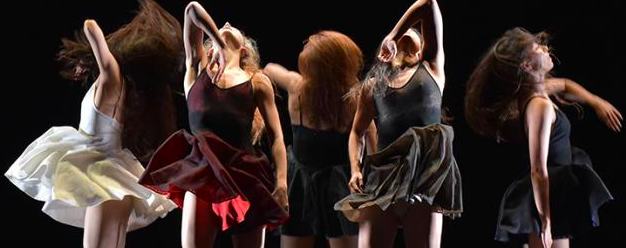Ballet Preljocaj’s performance of La Fresque showed a surprising amount of variety in an hour and a half. There was ballet, folk dance, modern, contemporary, theater, graphic design, and aerial elements at play. I don’t think all of which were necessary to supplement the intended plot of the choreography, but they were unexpected and interesting nonetheless. The ballet sought to investigate “the mysterious relations between representation and reality, sites at which the dance creates the bonds that link the fixed image and movement, instantaneity and duration, the live and the inert” via a traditional Chinese tale about a painting.
The original story of “The Painting on the Wall” was included in the program to better contextualize the evening length performance. It is as follows.
Once upon a time, there were two travelers, one called Chu and the other Meng. One a rainy, windy day, they arrived at a small temple. In this peaceful place where the silence was disrupted only by squalls of rain, a hermit who lived there invited the two travelers to look at a magnificent fresco painted on the temple wall. The fresco showed a group of girls in a corpse of parasol pines. One of them was picking flowers. She was smiling sweetly, her lips were bright as the flesh of cherries, and her eyes were bright. Chu was fascinated by her long, loose dark hair, the symbol of girls and single women. He stared at the girl so intensely for such a long time hat he felt as if he as floating in the air and was transported inside the painting. The adventure lasted for several years, years of idyll and happiness, until one day some warriors chased Chu out of the world of the fresco. When he returned to the real world, his friend mend had only been looking for him for a few minutes. The two friends looked at the fresco. The girl was still there, but her hair was now in a magnificent chignon, the symbol of a married woman.
Before this show, I’d never seen a story told thoroughly through contemporary/modern dance forms. It felt like a reprise of a story ballet, rather than interpreting the piece’s meta meaning, which is what Im accustomed to doing. The passing scenes onstage corresponded perfectly to the provided traditional Chinese tale, which was beautiful to see. The two men were introduced first then taken to the anticipated painting. The fresque was denoted by stage elements enclosing the space on a vignette of women. They devoted themselves to a dance with their hair before inviting the man inside their world. Before my eyes, a love story unfolded between a young woman and man, just as described in the program. Their pas de deux was tender and grateful, mimicking their growing kin. It was clear that time was passing. The stage darkened, a door smacked the ground out of nowhere, and let light leak through exposing outlines of warriors; the same warriors that banish the man from the painting. Just as quick as he stepped into the frame, he rolled out of the frame: back to his real life. No time had passed outside of the painting, but he’d lived half a lifetime inside the painting. The show ended in that realization, bringing hush and heartbreak over the audience.
I had initial reservations about this performance. Given Ballet Preljocaj’s company ethnodemographics, I was worried that a classic Chinese story was going to be appropriated by Eurocentric culture. Tokenization and exoticism are concepts that I am extremely sensitive to as a Filipino American, and I definitely did not want to see in-genuine fascination with a culture that’s largely unsupported outside of trends. I think the performance was definitely a Western version of the famous Chinese tale, but more importantly, I think it was the concepts within the story rather than the culture that were being examined and used as inspiration. The choreography was less about Chinese elements, and more about the idea of what it means to overcome the laws of time and space and jump between dimensions.
(Image credit: Google images)



Leave a Reply
Be the First to Comment!